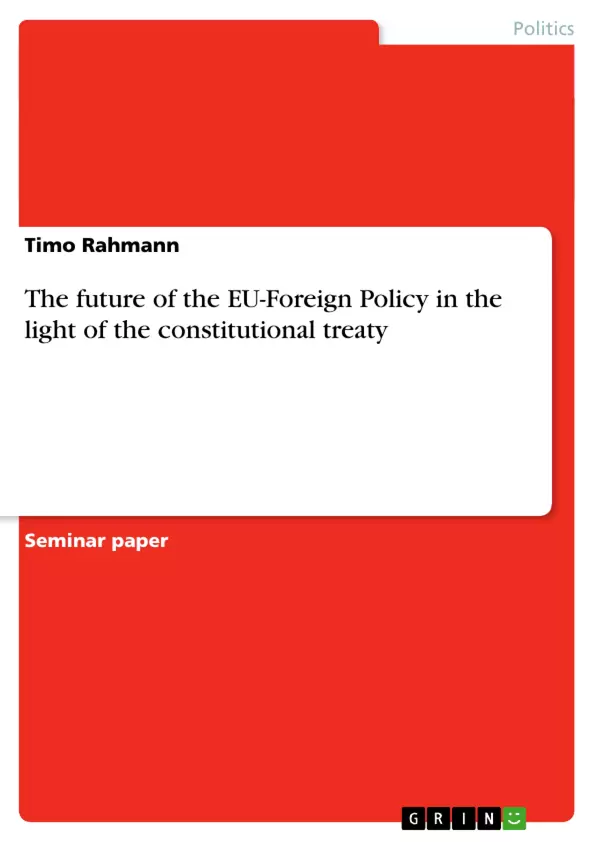A common European policy in fields of Foreign and Security Affairs has always been one of the crucial points of ongoing European Integration. It seems suitable that one can find here a point where the controversial debate about a supranational or a more intergovernmental character of the Union manifests itself. Since the external relations of a nation-state are still considered as the core of national qualities the activities and authorities of the EU in this area are consequently much more disputed than, for instance, issues only regarding the Common Market. From the early days of European integration on, the EU has been trying to enhance its ability to perform as a unified and effective actor on the global stage. However, to some extent many of the purposes remained ambitious rhetoric. Great expectations with little or no chance of actually coming to fruition, this could, if you put it in a nutshell, apparently be an easy and appropriate description of the dilemma the EU foreign and security policy suffers. Many observers expected a fundamental shift with the work of the constitutional convention. The arising euphoria about the Treaty establishing a Constitution for Europe (hereafter: TCE) had soon worn off since the constitutional breakthrough has not happened. This paper concentrates on the impact of the TCE on the future of the Common Foreign and Security Policy (CFSP) and in particular on Foreign Policy rather than the security aspects. It focuses on the question whether there is great probability that the TCE will improve Europe’s capability to act according to the demands the Union made on several occasions on itself. In order to discuss this, the paper will recapitulate the main developments and outlines of the CSFP up to now in a first step from a rather historical perspective . T he spotlight will turn to the current discussion about the constitution and its consequences in chapter three. This section will include a rather technical look on the constitutional arrangements but also an analysis of potentials and shortcomings lying in the TCE.
Chapter VI will deal with attempts at explanations and will therefore briefly discuss major theories of European Integration and their explanatory capacity. A last part is reserved for some concluding remarks and brief outlook.
Inhaltsverzeichnis (Table of Contents)
- I.) Introduction
- II.) EU Common Foreign Policy up to now
- - Developments and Outlines
- III.) The Institution: Changes and Constants concerning the CSFP
- IV.) Potentialities and Shortcomings of the Provisions for the CSFP
- V.) Concluding Remarks
- VI.) Bibliography
Zielsetzung und Themenschwerpunkte (Objectives and Key Themes)
This paper examines the impact of the Treaty establishing a Constitution for Europe (TCE) on the future of the Common Foreign and Security Policy (CFSP), particularly focusing on Foreign Policy. It aims to assess whether the TCE will enhance Europe's ability to act effectively on the global stage. The paper analyzes the evolution of the CSFP, the constitutional arrangements within the TCE, and the potential for both progress and shortcomings in the policy's implementation.
- The development and outlines of the CSFP up to the present.
- The institutional changes and constants concerning the CSFP under the TCE.
- The strengths and weaknesses of the provisions for the CSFP within the TCE.
- The impact of the TCE on Europe's ability to act effectively in foreign affairs.
- The potential for a more proactive role for Europe in international relations.
Zusammenfassung der Kapitel (Chapter Summaries)
- I.) Introduction: This chapter introduces the topic of the EU's Common Foreign and Security Policy (CFSP) and its historical context. It highlights the debate surrounding the supranational vs. intergovernmental nature of the Union and its role in international affairs. It also sets the stage for the paper's central question: will the Treaty establishing a Constitution for Europe (TCE) significantly improve the EU's ability to act effectively in foreign affairs?
- II.) EU Common Foreign Policy up to now - Developments and Outlines: This chapter examines the evolution of the CFSP, starting with its origins in the European Political Cooperation (EPC) of the 1970s. It traces the development of the CFSP from its initial attempts at coordination to its inclusion in the Maastricht Treaty of 1991. The chapter analyzes the factors that have contributed to both successes and limitations in the implementation of the CFSP.
- III.) The Institution: Changes and Constants concerning the CSFP: This chapter focuses on the institutional changes and constants related to the CSFP within the framework of the TCE. It explores the constitutional arrangements that aim to strengthen the EU's capacity for foreign policy action and its potential impact on the decision-making process.
Schlüsselwörter (Keywords)
This paper primarily addresses the Common Foreign and Security Policy (CFSP) of the European Union (EU), particularly focusing on the future of the CFSP in light of the Treaty establishing a Constitution for Europe (TCE). Key themes include supranational vs. intergovernmental integration, the EU's role in international affairs, the impact of the TCE on foreign policy decision-making, and the challenges of achieving a coherent and effective European foreign policy. It examines the historical evolution of the CFSP and analyzes the potential for both progress and shortcomings under the TCE.
- Arbeit zitieren
- Timo Rahmann (Autor:in), 2005, The future of the EU-Foreign Policy in the light of the constitutional treaty, München, GRIN Verlag, https://www.grin.com/document/49090



